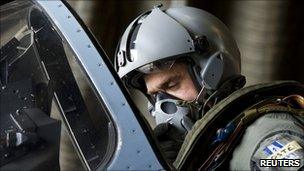Libya assault: UN's calculated gamble
- Published

French forces have already flown a mission over Libya
Some of the earliest key targets in the UN-backed assault on Libya are likely to be Colonel Muammar Gaddafi's command and control capabilities, as well as his air defences, which could still pose a threat to foreign aircraft.
British Prime Minister David Cameron has said that British forces are already in action in the Libya operation, which is codenamed Operation Ellamy in the UK (the Americans are calling it Odyssey Dawn).
At their home bases in the UK, Tornado GR4 ground attack aircraft and Typhoons for the air-to-air attack role are well prepared for what is to come.
British warships are already off the coast in Libya to ensure the arms embargo is respected.
Submarines have also been deployed for this mission, while experts say they would expect special forces to be in Libya already, having prepared the ground and assessed targets - their role, to send back vital information to those preparing and conducting the strikes from the skies or the seas.
The French have already bombed Libyan tanks and jeeps.
Demoralising Gaddafi's forces
The main British contribution to this coalition are fighter jets, Sentinel R1 and Nimrod R1 reconnaissance and surveillance aircraft (AWACs) to give vital information about what's happening on the ground, plus VC10 tanker planes for air-to-air-refuelling.
As part of the broad coalition, the US is also helping to remove the threat from Libya's air defences with sea-launched missiles.
However, commanders will face tough decisions on what to target in the coming hours and days, so accurate intelligence from the ground is essential.
While the hi-tech jets provided by France, the UK, Denmark, Norway, Canada and others should be able to dominate the skies easily, the mission to protect Libya's civilians runs a host of risks - from the dangers faced by pilots involved in the bombing raids, to the danger of civilian casualties if something goes wrong, especially with Col Gaddafi's forces so close to Benghazi.
For the allies in the air, it is a calculated gamble. The UN resolution is wide-ranging, giving the coalition leeway not just to disable Col Gaddafi's air defences but also target Libyan ground forces.
The hope is that this international show of strength from the air will demoralise his forces rapidly, and encourage them to flee or defect.
At the very least, his ground forces will need to be pushed back from Benghazi and other rebel areas, if civilians are to be protected from attack. The Libyan forces loyal to Col Gaddafi already have very stretched supply lines across the open desert, which will be vulnerable to attack.
But while the coalition in the air has a huge array of resources, those taking part are all too aware that their enormous firepower must be used carefully to ensure they do not endanger the very people the allies are there to protect.